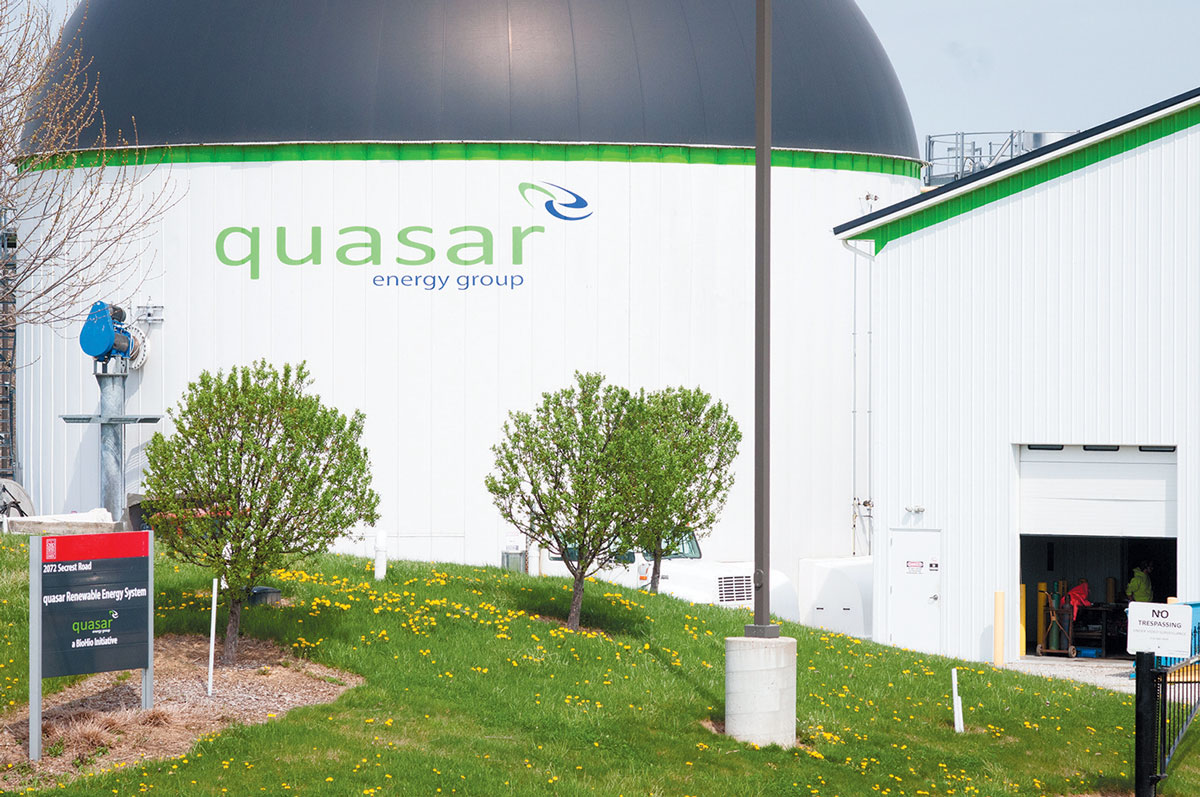Quasar Energy Group: A Stomach for Slurry and Sludge
When it comes to digestion, the human body is fairly good at it. And that’s why when it comes to reusing waste to produce energy, a giant stomach seems to be the way to go. These huge stomachs are called anaerobic digesters and Ohio happens to have the highest concentration of complete mix anaerobic digesters operating in the country. Quasar Energy Group, headquartered in Cleveland, has 18 anaerobic digesters in Ohio, with its facility in Columbus adding more than 300 tons of biomass daily to its digesters.
The result? Approximately one megawatt of electricity is produced per hour per digester and not a single chemical is used in this purely biological process.
Biomass is a wide descriptor for fats, oils, grease, sludge, food, waste and other organic residuals. And their reuse plays a crucial part in mitigating the effects of global warming. When organic residuals are trapped in landfills, they produce methane. According to the Sierra Club, American landfills contribute approximately 17% of global warming methane to the atmosphere and transportation of food waste to landfills alone requires at least 140 million gallons of fuel each year.
From start to finish, biomass can take anywhere between 22 and 28 days to transform into biogas within an anaerobic digester. But before that is possible, the biomass spends about three days in a feedstock receiving tank where it is mixed and becomes a homogenous slurry.
Then the slurry enters the digester—but the digester doesn’t just model a stomach. It models the complete digestion process in humans from enzymes breaking down starches, as saliva does in the mouth, all the way to gas production, as the anaerobic digestion process ends in biogas/methane production. But this model is more efficient than its muse.
“Our bodies aren’t as efficient. We’re not eating foods that can be readily broken down while it passes through, so what’s left is still 70% volatile,” says Mel Kurtz, president of Quasar, where volatile means that organics in the waste stream can still be converted to methane through a biological process.
If our bodies aren’t efficient, our ways are also not resourceful. According to Mel, 35% of the world’s food is wasted.
Acknowledging the waste first-hand, the Blackwell Inn and Pfahl Conference Center has a Grind2Energy machine produced by In-SinkErator that grinds its waste, which is then kept in a holding tank where Quasar trucks will visit, vacuum the ground waste out of the tank and then bring it to the aerobic digester.
The energy created from this waste will go onto the Columbus power grid and then the process repeats, as the Blackwell provides Quasar with approximately four to six tons of waste per week.
The Blackwell has been contributing its waste to Quasar since 2011 with no monetary benefit, and in fact pays to hand off the waste. For Lori Pratt, food and beverage director at the inn and conference center, it’s a matter of doing the right thing.
“[It’s about] reducing our carbon footprint and striving for sustainability goals we have set to make a difference,” says Lori.
But the Blackwell isn’t the only place in town, or in the state, that feeds its waste to these massive munchers.
Cleveland’s Indians and Browns stadiums as well as its Horseshoe Casino are just a few other locations with an InSinkErator Grind2Energy machine that processes waste to then feed it to
Quasar’s anaerobic digesters. And that’s just the surface. More than 100 Ohio restaurants and destinations contribute to Quasar’s renewable energy with the gift of waste. Quasar has state legislation to thank for a role in increasing its customers. Ohio’s mandate on required grease traps makes Quasar a natural beneficiary of the could-have-been-slippery situation. Bob Evans is one of Quasar’s grease contributors.
With more waste contributors come more options for energy use. At Quasar’s Zanesville and Columbus production facilities, methane is upgraded to motor vehicle fuel. Other locations use the resulting methane as fuel for generators that produce electricity for local power companies or PJM, an electricity provider for the entire Eastern Seaboard. However, for Mel, there is so much more potential.
“There are over 7,000 digesters in Germany alone, while there are only several hundred in the entire U.S. So, there’s a huge opportunity to do good biologically in the U.S. and if all of the organic residuals in organic waste was repurposed in Ohio, we could produce the equivalent of 20% of the total motor vehicle fuel consumed,” says Mel. “Ohio consumes about five billion gallons; we could produce one billion gallons of clean, renewable fuel from the anaerobic digesters. It will just take time; we’re getting there.”
Taking advantage of a portion of waste’s potential nationwide, Quasar has 24 anaerobic digesters operating at 14 facilities across Ohio, New York, Massachusetts and Maine.
Quasar surely knows about leftovers when it comes to biomass—but also when it comes to their own operations’ efficiency. Each facility needs 9% of the energy it produces to operate, leaving a large plate left for energy uses of all kinds.
“Any one of our facilities is about 9% parasitic load,” says Mel. “So that means we have over 90% of surplus energy, which is why anaerobic digesters are considered very efficient—because we don’t waste the energy, then we’re giving it back to the grid; we’re making fuel, making heat.”
Giving back also comes in the form of education. Quasar has helped The Ohio State University Agricultural Technical Institute located in Wooster in directing the curriculum of its two-year program.
“It’s for the purpose of creating young interested adults so that they can participate in this sustainable venture,” says Mel, hinting that a sustainable world can only happen with a sustained interest of its people.
Quasar Energy Group
5755 Granger Rd., Suite 320, Cleveland, Ohio 44131
216-986-9999






